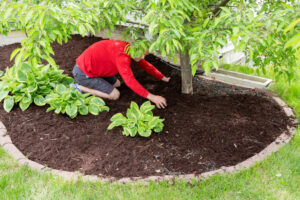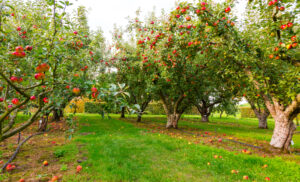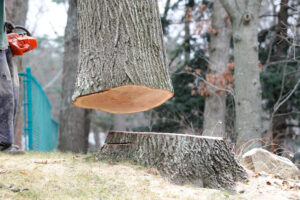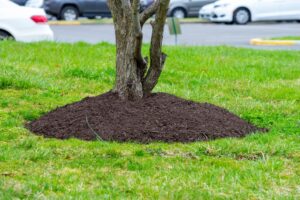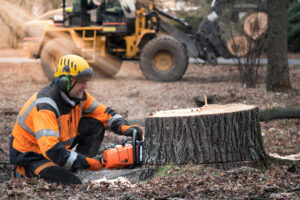Tree Mulching
Mulching is a valuable practice for maintaining the health and appearance of your trees. When done correctly, it can provide numerous benefits, such as conserving moisture, suppressing weeds, and insulating the soil. In this comprehensive guide, we’ll explore the advantages of mulching, discuss various types of mulch, and share expert tips for proper mulching techniques.
Benefits of Mulching
Moisture Retention
Mulch acts as a barrier that slows down the evaporation of water from the soil, helping to keep the tree’s roots moist. This is particularly beneficial during periods of drought or hot weather.
Weed Prevention
By creating a physical barrier, mulch can suppress the growth of weeds around the base of the tree. This reduces competition for water and nutrients, promoting healthier tree growth.
Insulation
Mulch insulates the soil, helping to regulate its temperature. This protects the tree’s roots from extreme heat in the summer and cold in the winter.
Aesthetic Appeal
A well-mulched tree can enhance the visual appeal of your landscape, creating a neat and polished appearance.
Types of Mulch
Organic Mulch
Organic mulches are made from natural materials that decompose over time, enriching the soil with nutrients. Examples include:
- Bark chips or nuggets
- Shredded leaves
- Grass clippings
- Compost
- Straw
Inorganic Mulch
Inorganic mulches are made from materials that do not decompose. While they don’t provide nutrients, they still offer insulation and weed prevention. Examples include:
- Gravel or crushed stone
- Rubber mulch
- Landscape fabric
How to Choose the Right Mulch for Your Trees
Tree Species
Consider the specific needs of your tree species when selecting mulch. Some trees prefer acidic soil, while others prefer a more neutral pH. Choose a mulch that supports the tree’s natural preferences.
Climate and Season
In colder climates, opt for a mulch that provides better insulation during the winter months, such as bark chips. In warmer climates, a lighter mulch, like straw or grass clippings, may be more appropriate.
Local Availability
Consider locally available materials to reduce transportation costs and environmental impact. For example, if you live in an area with abundant straw, it may be more cost-effective and sustainable to use it as mulch.
Proper Mulching Techniques
Applying Mulch
To apply mulch, follow these steps:
- Remove any existing grass or weeds from around the base of the tree.
- Spread the mulch in an even layer, extending it to the tree’s drip line.
- Avoid piling mulch against the tree trunk, as this can promote rot and attract pests. Instead, leave a few inches of space around the trunk, creating a “mulch-free donut.”
- Ensure the mulch layer is between 2-4 inches deep, as thicker layers can suffocate the tree roots.
How Much Mulch to Use
The amount of mulch you need will depend on the size of the area you’re covering and the depth of the mulch layer. To calculate the volume of mulch required, use the following formula:
Volume (cubic feet) = Area (square feet) x Depth (feet)
For example, if you’re mulching a 10-foot diameter circle around a tree with a 3-inch deep layer of mulch, the calculation would be:
Area = π × (radius)^2 = π × (5)^2 ≈ 78.54 square feet
Depth = 3 inches ÷ 12 inches/foot ≈ 0.25 feet
Volume = 78.54 square feet × 0.25 feet ≈ 19.64 cubic feet
So, you would need approximately 19.64 cubic feet of mulch to cover the area around your tree.
Mulch Maintenance
Regularly inspect and maintain your mulch to ensure it continues to provide the desired benefits. This includes:
- Fluffing the mulch improves air circulation and prevents compaction.
- Checking the mulch depth and adding more, if necessary to maintain the optimal layer thickness.
- Removing any weeds that manage to grow through the mulch.
Common Mulching Mistakes and How to Avoid Them
Volcano Mulching
One of the most common mulching mistakes is “volcano mulching,” which refers to piling mulch high against the tree trunk. This practice can lead to rot, disease, and pest problems. Always leave a few inches of space around the tree trunk when applying mulch.
Using the Wrong Type of Mulch
Selecting an inappropriate mulch for your tree species or climate can cause more harm than good. Research the specific needs of your tree and choose a mulch that supports its growth and overall health.
Insufficient Mulching Depth
Applying too thin a layer of mulch can reduce its effectiveness in retaining moisture and suppressing weeds. Ensure your mulch layer is between 2-4 inches deep for optimal results.
Proper mulching is an essential practice for maintaining the health and beauty of your trees. By choosing the right mulch, applying it correctly, and avoiding common mistakes, you can provide your trees with the protection and support they need to thrive. Consult with a professional arborist or landscaper if you have questions or concerns about mulching your trees, as they can offer expert guidance tailored to your specific situation.

